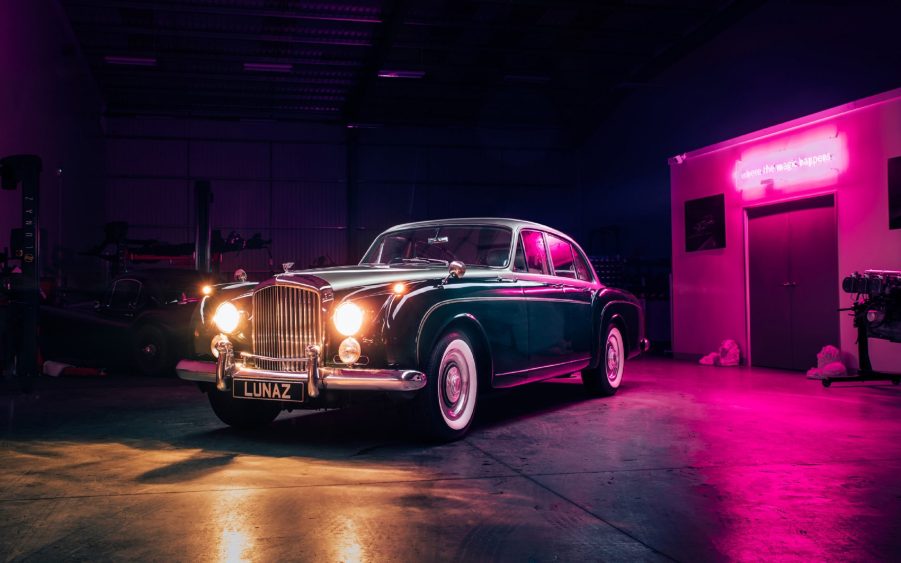
The Classic Car Electric Conversion Business Is Fully Charged
Reinvigorating classic cars through restomodding has frankly exploded over the years through the rise of firms like Singer and Icon. Whether you’re into Porsche 911s, vintage Minis, classic Range Rovers, or something completely different, there’s likely a shop that can breathe new life into it. But while not every owner wants a Singer-style build, there is one that people are increasingly asking for. And that’s giving classic cars electric conversions.
British firm Lunaz is at the center of a booming classic car electric conversion market

Last year, British soccer—sorry, football star David Beckham made some waves when decided to invest in a car shop. But not just any car shop: Lunaz, which specializes in electric conversions for classic cars. At the time, it had already EV-swapped a Jaguar XK120, several Aston Martins, and a vintage Rolls-Royce. And it was just rolling out its classic Bentley Continental projects.
Considering the Continental build starts at $476K, you might imagine Lunaz’s clientele is rather rarified and/or limited. But that’s not the case. To quote Forbes, “the business of restoring British classic cars and replacing their engines with electric motors is booming.”
Quite simply, Lunaz can’t perform electric conversions on classic cars fast enough. The shop is sold out for 2022 and 2023 even after a 500% increase in staff (to 120 employees). And this comes after Lunaz bumped its annual production up 50% to 110 vehicles and expanded its facilities by 400%.
Lunaz’s business boom is just one sign of the rapid rise of vintage EV swaps, though. Multiple automakers have released one-off electric restomod projects, including Nissan and Hyundai. Jaguar and Mini both offer in-house electric conversions for classic car owners. And after showing off the F-100 Eluminator concept, Ford made its powertrain available as a crate motor. But you can’t get one as of this writing, because it, too, is sold out.
Why are so many people interested in classic car electric conversions right now?
In short, EV swaps for classic cars are having a moment right now. And there are several potential reasons why.
For one, like gasoline-powered restomods, these electric classics offer modern performance and daily drivability. They still have vintage styling, but it now comes with high-quality materials and technology like A/C, heated seats, and even infotainment. Plus, while some vintage cars are surprisingly nippy, giving them EV drivetrains lets them more than keep up with traffic.
However, unlike ICE restomods, these electric conversions don’t have tailpipe emissions. That lets owners keep their classic cars alive without significant environmental guilt. It’s something that many of Lunaz’s clients, which are younger than “typical luxury car [buyers],” look for, Forbes says. And for the truly environmentally minded, the UK shop is big into upcycling, offering carpets made from recycled fishing nets and 100% recycled interior fabrics.
In addition, EV drivetrains are easier to maintain than antique engines. While they’re not maintenance-free, they don’t require carburetor cleaning, valve adjustment, new belts, frequent oil changes, and so on. That means owners can actually use their classic cars as cars rather than squirreling them away in climate-controlled garages. And in the process, they might turn some EV nay-sayers into converts.
How much do these conversions cost?
As noted earlier, Lunaz’s electric conversions don’t come cheap. Even its cheapest build, the Range Rover one, starts at roughly $395K, Forbes reports. Admittedly, there are cheaper EV swaps out there. But even something ‘simple’ like a Zelectric Beetle typically costs around $50,000.
However, as is the case with electric car batteries, these classic conversions could get less expensive in the future. As more crate motors become available, part costs should go down. Also, keep in mind that, generally speaking, a ‘classic car’ is any vehicle that’s over 25 years old. Restoring a 1960s Beetle likely takes more time and money than, say, an early ‘90s Mercedes.
For some, the thought of swapping out an original Porsche flat-six or GM V8 for an electric motor sounds like sacrilege. But that isn’t stopping the likes of Lunaz from charging right ahead.
Follow more updates from MotorBiscuit on our Facebook page.


